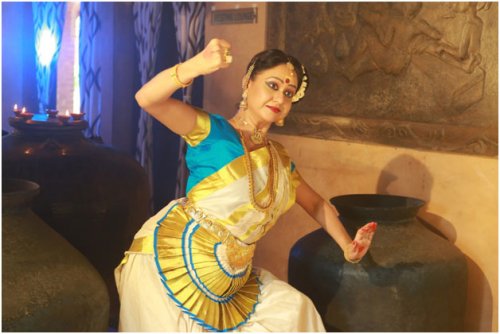 |  Follow us    
  |
 |  Follow us    
  |
 Mali's poem finds lyrical expression in the film Neelima - Dr. S D Desai e-mail: sureshmrudula@gmail.com August 3, 2018 The verbal art of poet V. Madhavan Nair (Mali) in a short and characteristically simple poem finds lyrical expression in Ayswaria Warier's short Malayalam dance film Neelima with English subtitles. Poetry is the art of the soul - Aathmanaha Kalaa, Bhavbhuti said. It is exhilarating to see the beauty of the poem getting even enhanced slightly while it is translated to the medium of cinema through her Mohiniattam dance with N. N. Sivaprasad's soulful vocal recital, appropriately subdued to suit the suppleness of the movement and the ethereal mood. Muralikrishna's competent cinematography, at times leaving the viewer spellbound, and good editing make no mean contribution to shaping the film as a piece of art. The film does not follow a linear narrative of incidents as in a story. It conjures up evocative images rich in suggestive power. It is the dancer's imaginative visual interpretation of under-fifty poetic words in the space of twenty-three minutes - a veritable karnachakshusotsava. It presents a personal experience as of a mugdha intensely felt. The dancer, who has choreographed it, directed it with useful assistance from the cinematographer, sees herself as Neelima, the dancing nayika of the poem, who perceives and captures in her creative fancy all the hues of the blue in the precious sapphire she notices in the finger ring washed ashore on the unmistakable Kerala beach.  She had always been fascinated by this colour as the breathtaking
opening scene suggests. Now as the young dancer's soaring feeling of vismaya
matches the force of the surging waves, serene hues of blue enveloping
the universe open up to her. It is up there in the limitless expanse of
the cloudless sky, here in variegated peacock feathers and in the
unfathomable depths of the ocean. Lamps of realization having lit up
within as she sits lost in her thoughts she perceives yet another hue,
subdued and incomparable, such that no painter's brush can ever capture
anywhere in the three worlds. She is seen affectionately caressing child
Krishna. She had always been fascinated by this colour as the breathtaking
opening scene suggests. Now as the young dancer's soaring feeling of vismaya
matches the force of the surging waves, serene hues of blue enveloping
the universe open up to her. It is up there in the limitless expanse of
the cloudless sky, here in variegated peacock feathers and in the
unfathomable depths of the ocean. Lamps of realization having lit up
within as she sits lost in her thoughts she perceives yet another hue,
subdued and incomparable, such that no painter's brush can ever capture
anywhere in the three worlds. She is seen affectionately caressing child
Krishna.It is the ever-changing audio-visual images with the anchoring idea of the dancer exploring hues of blue in nature culminating in a shared spiritual belief that is of abiding interest in the dainty film Neelima. Ayswaria's Mohiniattam, the form that evolved here in Kerala, assumes irresistible charm in the film with the location changing from the Kerala beach to temple precincts to the open veranda of a spacious house to yet another even more spacious. Slow-paced, it is at its expressive best. The eyes speak, the movement is lithely graceful and the mudras become a vocabulary as if in a demonstrative dance lesson. Glimpses of the luxuriance nature offers on this land, the grandeur of architecture even where it is simple, the resplendent ambience that the brass diyas create, the permeating blue, recurring images of peacock feathers and the sounds of music in silence all integrate and spell magic. The image of child Krishna vanishes as mystically as it seemed to appear earlier in a reverie. Now, with lamps lit up around her, eyes dazed, she sees a tall human figure, broad in frame, his face invisible, walking in dignity towards her. Is it the poet himself, whose birth centenary is being celebrated during the year? He draws near, sits and hands her a tamrapatra. She receives it in disbelief and reads it with reverence and thrill. The poet's soul blesses this 'narthaki' on making a film based on the poem. Film Neelima is a tribute by a dancer to a poet. Dr. S.D. Desai, a professor of English, has been a Performing Arts Critic for many years. Among the dance journals he has contributed to are Narthaki, Sruti, Nartanam and Attendance. His books have been published by Gujarat Sahitya Academy, Oxford University Press and Rupa. After 30 years with a national English daily, he is now a freelance art writer. |